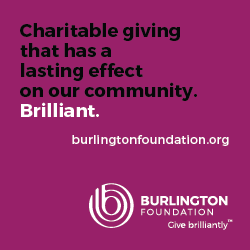 By Staff By Staff
April 17, 2014
BURLINGTON, ON.
The kids love them, grandparents have a great time hiding the coloured eggs and parents learn to deal with the sugar high that follows that Friday morning fun.
It’s something we do – harmless but at some point those children should hear the story and let them decide as they grow what they choose to believe.
But there is another culturally historic story behind those Easter eggs.
 It’s not the forty loaves story is it? Easter eggs, also called Paschal eggs, are decorated eggs that are often given to celebrate Easter or springtime. As such, Easter eggs are common during the season of Eastertide. The oldest tradition is to use dyed and painted chicken eggs, but a modern custom is to substitute chocolate eggs, or plastic eggs filled with confectionery such as jelly beans. Eggs, in general, were a traditional symbol of fertility, and rebirth.
In Christianity, the celebration of Eastertide includes Easter eggs symbolizing the empty tomb of Jesus: though an egg appears to be like the stone of a tomb, a bird hatches from it with life; similarly, the Easter egg, for Christians, is a reminder that Jesus rose from the grave, and that those who believe will also experience eternal life.
One can argue for years over the concept of a risen Christ – but the facts are, there was a man who was crucified – his name was Jesus. The rest of the Christian tradition is a matter of faith.

 By Pepper Parr By Pepper Parr
April 16. 2014
BURLINGTON, ON.
While the current city manager is out looking for new digs in Calgary as he transitions from one city to another, the business of the city still has to move forward.
The Development and Infrastructure Committee released their 12th Update on Air Park matters earlier in the week. The appeal by the Air Park to the decision handed down in Ontario Superior Court will be heard on June 11th – quite a few people from Burlington will be trooping into town for that event; we understand that most of the ward 6 candidates will be in that courtroom in Toronto to take it all in.
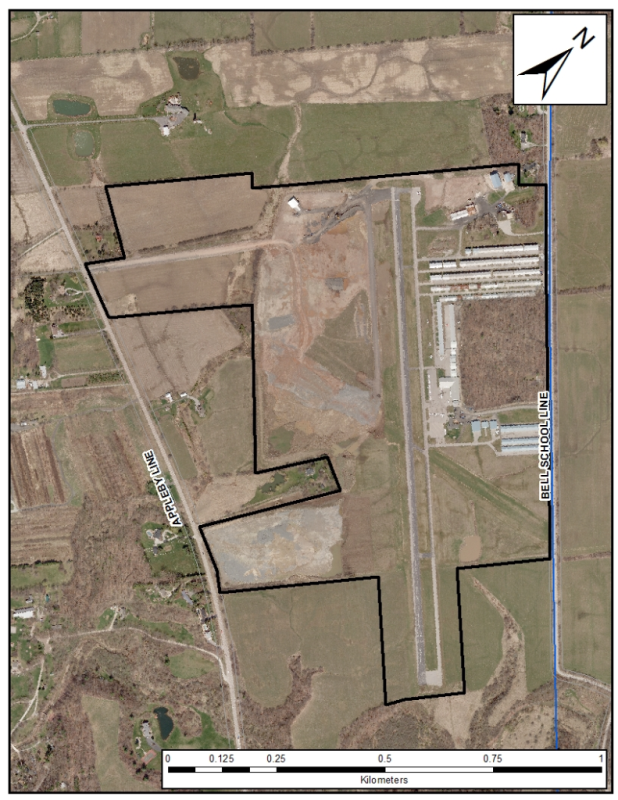 How much of the landfill on the Air Park property is toxic and how toxic? – are questions both the city and the residents want answered. The answers to those questions are tangled up in Privacy red tape. While all this is taking place both the city and north Burlington residents want to know – just what is in all that landfill that was dumped on the site in the past five years?
Everyone suspects there is some level of toxicity in that landfill. The city hired Terrapex to do some tests and the Ontario Ministry of the Environment got onto the property and did tests of their own.
In their appeal the Air Park took significant exception to the reports provided to the city by Terrapex and challenged some of the data.
At some point there will be a decision on what the Air Park has to do – at this point there is a decision from a judge saying the Air Park has to comply with the municipal by law. That decision stands until a higher court overturns it.
Will the city require the Air Park to remove all of the landfill or just some of the landfill or maybe the city will decide it can all stay in place?
What will determine the direction the city takes, assuming the Air Park appeal is lost depends on just what is in all that earth.
And other than the Terrapex report – we don’t know.
The Ministry of the Environment did testing but they haven’t released the information. Why? Privacy issues. Someone, believed to be the Air Park, has taken the position that the information is private and cannot be released without the permission of the person whose privacy is being harmed.
Many in the community find this both incredible and close to unbelievable. But it is a real problem for the city who now have planners working their way through the privacy process. Planner Mike Crowe started out by asking the MOE for the information; they said no and the city used the Freedom of Information process to get the information. When the MOE continued to say no – the city asked for a mediation – and that is where things are at the moment.
If a mediation fails the city can up the pressure and ask that their Freedom of Information request be adjudicated. It does get messy and very bureaucratic.
 Are these dead fish victims of a hard winter – or was there something in the pond water that did them in. The owner of the property is very anxious and wants to know why previous landfill testing results are not available. They see this as a matter of opublic health and not individual privacy rights. She called the Ministry of the Environment who had some of their people out on the property testing within a day. The belief in north Burlington is that the landfill is toxic, that the MOE knows it is toxic but can’t say so publicly because of the privacy mess.
But a request for testing of pond water that had hundreds of dead fish will give both the MOE and the property owner some additional data.
 That rise of land behind the pond on an Appleby Road property is not a natural feature – it is a 30 foot + hill made up of landfill that was placed on the land without proper approvals. Water seeping through that landfill flows into the pond. North Burlington residents aren’t stopping there. They have prepared a petition and sent it along to the MOE people. The petition is from the Rural Burlington Greenbelt Coalition (RBGC), but they aren’t releasing the contents of that petition. One of the things they do want is better transparency from the MOE.
The MOE is prepared to meet with the community – but until the privacy issues are cleared up – there isn’t all that much they can do.
What we have is two level of bureaucracy fighting with each other over test data that is critical to understanding what the problems really are – with the owner of the property using privacy rules to keep the information confidential.
Messy.
The north Burlington locals don’t help their cause all that much when they withhold the contents of their petition to the MOE. What is it they want and is it reasonable?
Background files:
In the beginning the buck got passed around.
Record length city hall debate on Air Park site.
Air Park digs in its heals.
City seeks an injunction to stop landfill dumping.
Air Park sues the city – city takes off the gloves.
City wins Air Park court case

 By Pepper Parr By Pepper Parr
April 11, 2014
BURLINGTON, ON.
Was it the cold winter that resulted in hundreds of dead fish floating on the pond of the Appleby Line property that is surrounded on three sides by the Air Park land fill or is the death of the fish the result of toxic and silt filled water now in the pond?
The argument as to whether the land fill was going to do any real damage has been simmering in the background. Some testing was done but the
 A spring fed pond with hundreds of fish – normally. Today wasn’t a normal day on the Appleby Line property. Hundreds of dead fish were floating n the water this morning. Ministry of the Environment got involved in a struggle over who was entitled to the information from their testing results – privacy issues came into play and the privacy officers at every level of government seem to be taking the time they feel they needed to determine just who can see what.
 The spring fed pond is yards away from a mountain of landfill that was never properly tested when it was dumped on the property. Runoff from the landfill is now getting to the water table – dead fish are showing up in the pond. Some of the evidence may have come to the surface – literally, for one resident. Hundreds of dead fish were found floating on her pond this morning. That pond is yards away from a 30 foot high pile of landfill that is in place in violation of the city’s site alteration bylaw.
The property owner advises that the Ministry of the Environment will be on her property later today to test for contamination in the pond.
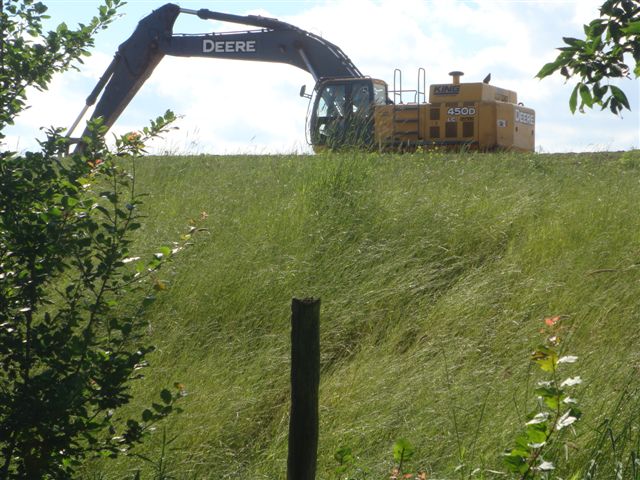 That crane sits atop a 30 foot high wall of landfill that is yards away from a pond that had hundreds of dead fish floating on it this morning. No one will be surprised if it is contaminated – they fully expected this to happen. It is the result of thousands of tonnes of untested landfill being dumped without the required permissions.
Everyone will feel badly for the property owners – but no one is going to fix the underground water course that may be damaged for decades.
A win of the appeal of the court case in which the city won its case – their bylaw is valid and the air park is bound by that rule – isn’t going to bring the dead fish in that pond back to life.
There is more damage to come as well. Individual livelihoods are being damaged here. What is this going to do to our best small city to live in reputation?

 By Staff By Staff
April 4, 2014
BURLINGTON, ON.
It’s hard to keep up with the different colours used by the corporate community and community organizations to signify interest in what they are doing. I think it all started with that American pop song: “Tie a yellow ribbon round the old oak tree” to celebrate the return of a person who wasn’t at all sure he would be welcome.
I thought that pink was taken by the CIBC bank people and their Run for the Cure to raise funds for cancer treatment but pink is also being used to recognize International Day of Pink
 Set in the east end of the city on New Street the Nelson Youth Centre has been serving youth since the 1980’s Each year on the second Wednesday of April, millions of people wear pink to remember that positive actions make a difference. On Wednesday April 9th, RBC will make a donation to the Nelson Youth Centre in Burlington to support their efforts to eliminate bullying and discrimination.
Nelson Youth Centre is an accredited Children’s Mental Health Centre that offers treatment programs for at-risk youth in Halton. Reconnecting Youth is a community based program focused on helping youth develop effective social/emotional skills, coping strategies and effective learning skills to transition into adulthood and become successful and independent. The program works with youth, families, schools and the community and provides mental treatment and support for youth between the ages of 14-17 who are experiencing moderate to severe mental health issues which significantly impacts their ability to cope.
Day of Pink is an international day against bullying and discrimination supported by RBC. Last year, more than 16,000 RBC employees wore pink to show support for this great cause; this year the bank is encouraging employees to wear pink and in Halton South we are also making a donation to the Nelson Youth Centre in Burlington.
The Nelson Youth Centre has a program called Reconnecting Youth that provides individual and group counseling for youth struggling with self-esteem, social/emotional issues and poor peer relationship issues.
Next week we will take a look at the people and programs at Nelson.

 By Staff By Staff
April 1, 2014
BURLINGTON, ON.
Starting today, right now actually you have to butt out in any city park. Burlington passed a bylaw in November of 2013 , to ban smoking in city parks and recreation facilities. Exceptions to the bylaw include LaSalle Park Pavilion; Discovery Landing; Paletta Mansion; and Tyandaga Golf Course. Smoking at these locations will be allowed in designated areas.
 A leisurely smoke in a park – comes to an end in Burlington today. Those locations generate revenue for the city.
It will be interesting to see how this works during RibFest.
 Weed rules are bending – expect to smell this at the Sound of Music. The Sound of Music will be different – at that event a different kind of smoking takes place and it looks as if the weed will become fully legal at some point.
The city says its parks will become smoke-free, joining a province-wide movement to create healthier outdoor spaces. . “Like our neighbouring municipalities, we wish to provide a place where people can enjoy their recreation time without the health hazards associated with smoking.”; except for those exceptions – hypocrisy rules!
Hamilton and Oakville put in place smoke-free parks and recreation bylaws in the summer of 2012. According to the Play, Live, Be Tobacco-Free website, 121 Ontario municipalities have adopted an outdoor smoke-free bylaw or policy.
Enforcement in Burlington will be self-regulated and self-enforcing, as it is in many municipalities.
We’d like to hear how that works out; I don’t think I’m going to tell some bruiser of a biker to but out at RibFest and apparently there isn’t going to be a bylaw enforcement officer roaming around to do any enforcement.

 By Staff By Staff
March 31, 2014,
BURLINGTON, ON.
There has been another outbreak of measles that has the capacity to impact people in Burlington.
Persons who have visited any of the following locations may have been exposed to measles:
Saturday, March 22, 2014:
The Queen’s Head (pub), 400 Brant Street, Burlington, 10 p.m. to 2 a.m.
Sunday, March 23, 2014:
Milestones Restaurant, 1200 Brant Street, Burlington, 7 p.m. to midnight
Wednesday, March 25 – Friday, March 27, 2014:
Joseph Brant Hospital, 1230 North Shore Blvd., Burlington
March 25, 7 p.m. to March 26, 9:30 a.m.
March 26, 3:30 p.m. to midnight
March 27, 11:15 a.m. to 2 p.m.
The Halton Region Health Department is following up individually with patients and individuals accompanying them who may have been exposed at Joseph Brant Hospital.
“Measles is preventable through immunization with two doses of measles vaccine,” stated Dr. Monir Taha, Halton Region Associate Medical Officer of Health. “Persons who have measles need to isolate themselves while they are ill and for four full days after the rash first appears. Always call ahead before going to a health care setting.”
Measles starts with cough, runny nose, red, watery eyes, and fever, and after about four days a rash begins on the face and moves down the body. There may be white spots inside the mouth. Measles spreads easily to persons who are not immune. Infants under one year of age, pregnant women, and persons with weakened immune systems can get very ill with measles. Complications of measles can include middle ear infections, pneumonia, croup, and inflammation of the brain. Learn more at www.halton.ca/measles.
If you think you may have measles and need to see a doctor, you must call ahead to the doctor’s office, walk-in clinic, or emergency department. This will allow health care staff to give you a mask to wear when you arrive and take you straight to a room in which you can be isolated. In a doctor’s office you may be given the last appointment of the day.
For more information, dial 311 or call the Halton Region Health Department at 905-825-6000, toll-free 1-866-442-5866 or visit www.halton.ca.

 By Staff By Staff
March 20, 2014
BURLINGTON, ON.
St. Luke’s Church Annual Spaghetti Dinner!
 In the Parish Hall 1382 Ontario Street, on Saturday April 5 with continuous servings of the best spaghetti & meat balls in town from 5:00pm to 7:00pm. In the Parish Hall 1382 Ontario Street, on Saturday April 5 with continuous servings of the best spaghetti & meat balls in town from 5:00pm to 7:00pm.
Tickets Adults $10.00
Children 12 & under $5:00
They want you to reserve – call 905-634-4345.
Cash bar serving Wine, Beer & Soft Drinks – these ARE Anglicans!

 By Staff By Staff
March 9, 2013
BURLINGTON, ON.
Cute name, conveys the message, and it might meet the needs of busy people with significant parent and child care responsibilities.
Imagine That offers a service that includes back-up care when there is a temporary disruptions in child, adult, or elder care that prevents them from fulfilling work obligations.
The reality of bustling city life: the commute, the traffic, the long work day of meetings and juggling multiple projects, the cell phone calls, emails, texts, and then of course family needs are thrown into the mix. Finding time for everything is a challenge, especially for those who have children, or are in need of adult or elder care.
Imagine That, originally a child care services operation, has expanded to offer back up care for individuals of all ages – children, adults and seniors, under the umbrella of Imagine That Family Care Services.
The services, a first of its kind, means employers can now set up Imagine That Corporate Family Backup Care for their employees.
 Managing that work life balance usually requires involving outsiders – where do you find the people who you can trust – and afford? “Our services offer employers and employees alike with that added piece of mind. Through the support of our professionally trained staff, employees now have the opportunity to utilize back-up care services like no other so that they can meet necessary work commitments.”
Anne Bonfigli, Director Sales & Marketing for Imagine That Family Care Services, explains it this way: our extensive services for family care are about supporting employees while helping keep work absenteeism to a minimum”.
“People out there want to excel in their careers and now have access to a support system that covers employees from all walks of life –from the trades and labour, to professionals, and all the way to Bay Street.”
The family care services are cost-effective and flexible and they are offered round the clock, 365 days per year.
Imagine That Family Care is a division of Bartimaeus Inc. Bartimaeus was founded in 1988. It is a Canadian-owned and operated company, committed to providing the highest quality services to individuals of all ages. The services of Imagine That were first offered in 2001. The expansion into Imagine That Family Care Services is a result of the company’s dedication to the highest quality of services that are safe, engaging, and professional.
Imagine That Family Care provides high quality child care, adult care and elder care to individuals, families and employers in Toronto and the Greater Toronto Area. Their Corporate Family Backup Care service is made available to employees, through their employer, often incorporated into their wellness programs. Their Hotel Family Care service is available to guests staying at premium Toronto hotels, whether they are visiting for leisure or business, and need a quality care for their child or senior who may be travelling with them. The Direct Family Care service is available to family members of all ages. The care providers arrive to an individual’s home, prepared with age-appropriate activities.

 By Staff By Staff
March 9, 2014
BURLINGTON, ON.
An accident on Mainway in Burlington earlier in the week was more than an Oakville resident’s body could handle; he died at the Hamilton General Hospital at around 3:30 pm yesterday.
Detective Constables from the Halton Regional Police Collision Reconstruction Unit (CRU) continue to investigate the matter. Police have not released the name of the victim and to date no charges have been laid against the driver of the vehicle.
This is the second traffic fatality to be investigated by the CRU in 2014, and the first in Burlington.
Background links:
Evening accident sends Oakville resident to hospital.

 By Emily Ferguson By Emily Ferguson
March 8, 2014
BURLINGTON, ON.
My name is Emily Ferguson and I am the sole individual behind Line 9 Communities. (This is a blog Ferguson writes about the communities along the path of the Enbridge Pipe Line 9 that runs from Sarnia to Montreal.)
I graduated from McMaster University with Honours BA Geography & Environmental Studies and a minor in Political Science.
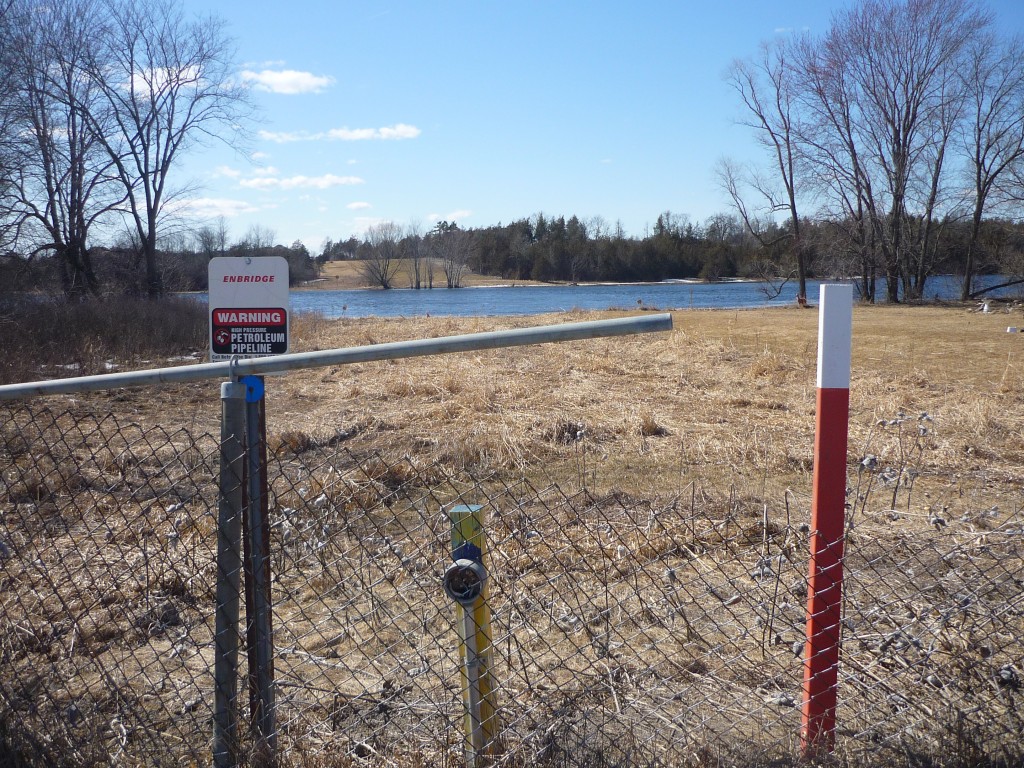 Emily Ferguson mapped every yard of the pipeline so that communities along its path could know just what was beneath the ground. I first heard about Line 9 at a climate conference in Ottawa in 2012. My interest led me to attend information sessions in Hamilton and surrounding area in early 2013. At one meeting in particular, I asked for a Line 9 information package which had been provided to Council. Although there were extra packages after the meeting, an Enbridge official denied my request and asked “Who are you working for”? The Enbridge team then proceeded to ask myself and a fellow community member for our driver’s licenses and said they would mail a package. Something about the encounter just didn’t feel right and we walked away without the information.
 Emily Ferguson – National Energy Board intervener, geographer. That was the turning point. I went home that night with so many questions. Why was I being denied access to information at a public meeting? What were they trying to hide? Why didn’t they want me to know where the pipeline was?
So I took it upon myself to map Line 9. Throughout an unimaginable number of late nights, I compiled satellite images, integrity data and publicly available information to create detailed maps of the 639 km pipeline.
I did it because they said no.
I did it because I felt the need to inform the public.
If Enbridge wasn’t going to adequately consult … who would?
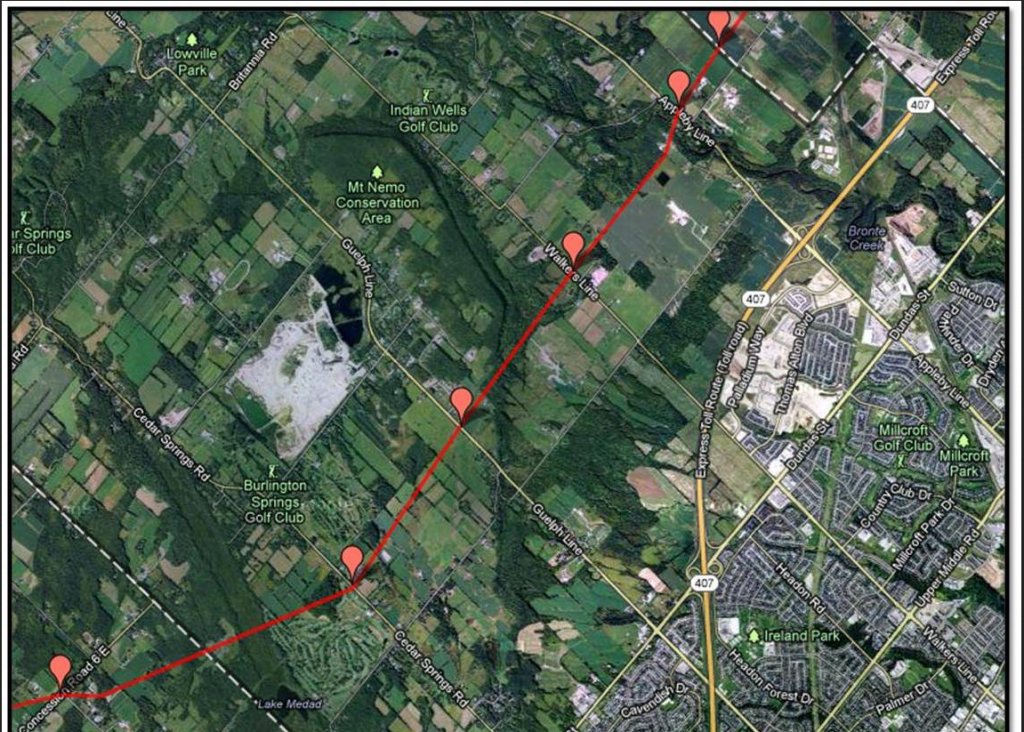 For Burlington – this is where the pipeline was located. I contacted multiple City Counselors along the line and sat down over coffee with many to discuss the proposal. The lack of information provided to municipalities shocked me. I proceeded to canvass neighbourhoods along the line to poll residents and provide details about open houses and how to get involved.
Line 9 Communities gained instant attraction. Although I blogged about the application, past spills, and changes to federal legislation, viewers wanted one thing … MAPS! Essentially they wanted to know, where is the pipeline and why don’t I know about it?
 Emily Ferguson mapped ever foot of the pipeline from Hamilton to Montreal and learned that the thing ran underground right behind her elementary school – the pipeline had always been a part of her life – She didn’t even know it was there. During the map creation, I found out that Line 9 crosses right through the small community where I grew up. The pipeline is located directly behind my public school playground in Glenburnie, ON, just north of Kingston. It also passes behind Seneca College in Toronto which I attended for three years. I had literally been living beside the line my entire life … and didn’t even know it existed. All of a sudden, things became very personal.
I felt compelled to learn everything I could about the project. My biggest supporter along the way was Eva Simkins – my Grandma. Although diagnosed with cancer in 2009, two weeks of radiation treatments gave us the gift of four extremely memorable years. We traveled, talked politics, did puzzles, celebrated, smiled and laughed. Through it all though, I knew there was that big question in her mind. Why me?
I wondered the same thing.
She held my hand as she peacefully passed away at sunrise on Earth Day of this year … just three days after I applied to be an NEB Intervener.
In my opinion, we accept the status quo far too often. At a Line 9 open house, an Enbridge official told me, “if we say it’s safe, it’s safe”. But I must question the safety of this pipeline. At almost 40 years old and only meeting the engineering standards of 1971, why is the NEB even considering the application? Enbridge has cited over 400 integrity digs (cracks, corrosion, dents) along the line in 2013 alone! They have also acknowledged that their in-line inspection tools do not detect all defects and that their Edmonton control center cannot sense pin hole leaks. With the current application before the Board, Enbridge is proposing to ship Bakken crude and diluted bitumen laced with drag reducing agent (DRA) chemicals – which include known carcinogens such as benzene – through our communities.
I have never had any malicious intent towards Enbridge. As a citizen of Canada and student of environmental politics, I have always been interested in energy issues, climate change, and a sustainable future for our planet. I believe in the strength of communities working together to achieve great things.
My mission through this entire process has been to raise awareness and promote a community discussion. We are living in a critical time. Will we continue to accept the status quo, or will we start asking the tough questions and demand a better future?
Editor’s note: I had an opportunity to interview Emily while she was thinking about applying to be an intervener at the National energy Board hearing. She wasn’t sure what she was going to do then and she needed quite a bit of encouragement to send in her application, which was an experience in itself. But on October 16th, 2013, Emily Ferguson, all 5’ 2” of her stood before one of the most powerful regulators in the country and gave “the best speech of my life”
Background links:
Burlington doesn’t take to the idea of a change in the flow of the Enbridge pipeline
National Energy Board give Enbridge a green light – with 30 conditions.
The Emily Ferguson maps.

 By Staff By Staff
March 7, 2014
BURLINGTON, ON.
A company engaged in garbage removal and hauling, and a supervisor have been found guilty of failing to ensure the safety of a worker who fell off a roof. The company was fined $75,000 and the supervisor has been sentenced to 45 days in jail. A company representative has also been fined $2,000 for obstructing a Ministry of Labour investigation.
The incidence took place in October of 2008, when workers were sent to an address to remove shingles from a one-storey bungalow. One of the workers was tossing loose shingles from the roof toward a bin and stepped back, then slipped. The worker rolled off the roof of the house and landed on a walkway. The injury resulted in permanent paralysis of the lower body. A Ministry of Labour investigation followed the incident.
 No safety harness for these workers. You can get sent to jail for that in Ontario. The injured worker testified to not being trained in the use of fall protection equipment, nor was any such equipment provided in the company-supplied truck used for transportation to and from the job site. As well, the worker indicated that the practice for payment for work was cash and that work was provided on an on-call basis. The worker identified J.R. Contracting Property Services as the employer and Teisha (Tina) Lootawan as the supervisor.
The court determined that the worker was an employee under the definition of the Occupational Health and Safety Act (OHSA), and that J.R. Contracting Property Services was the employer. The court also determined that Lootawan was a supervisor under the OHSA. As such, she failed as a supervisor to ensure that a worker wore protective devices as required by law, and failed as a supervisor to take the reasonable precaution of ensuring that an adequate form of fall protection was provided where a worker is exposed to a fall hazard of more than three metres.
As the Ministry of Labour investigation proceeded, the company was requested to provide documentation that included employment and telephone records. A company representative, Andrew Joshua Haniff – who accepted the call from the Meadowvale Road homeowner requesting the company’s services – attended a meeting on December 23, 2008, but refused to answer any of the inspector’s questions. He was convicted by the court of obstructing an inspector.
The jail sentence and fines were imposed by Justice of the Peace Mary A. Ross Hendriks. The court heard seven days of testimony over 2011 and 2012; judgment was passed April 18, 2013.
The investigation, the court case and the decision point to the responsibility corporations and their senior staff have for the safety of their workers.

 By Staff By Staff
March 6, 2014
BURLINGTON, ON.
The National Energy Board will release its decision in Calgary Thursday on Enbridge’s controversial plan to increase flows in Line 9 that runs between Sarnia and Montreal and across the top of Burlington, to ship bitumen from the Alberta tar sands through the 39-year old pipeline.
The NEB decision is expected to respond to demands from the Ontario government and cities like Hamilton that the proposal be subjected to an independent engineering assessment and that Enbridge be forced to conduct hydrostatic testing.
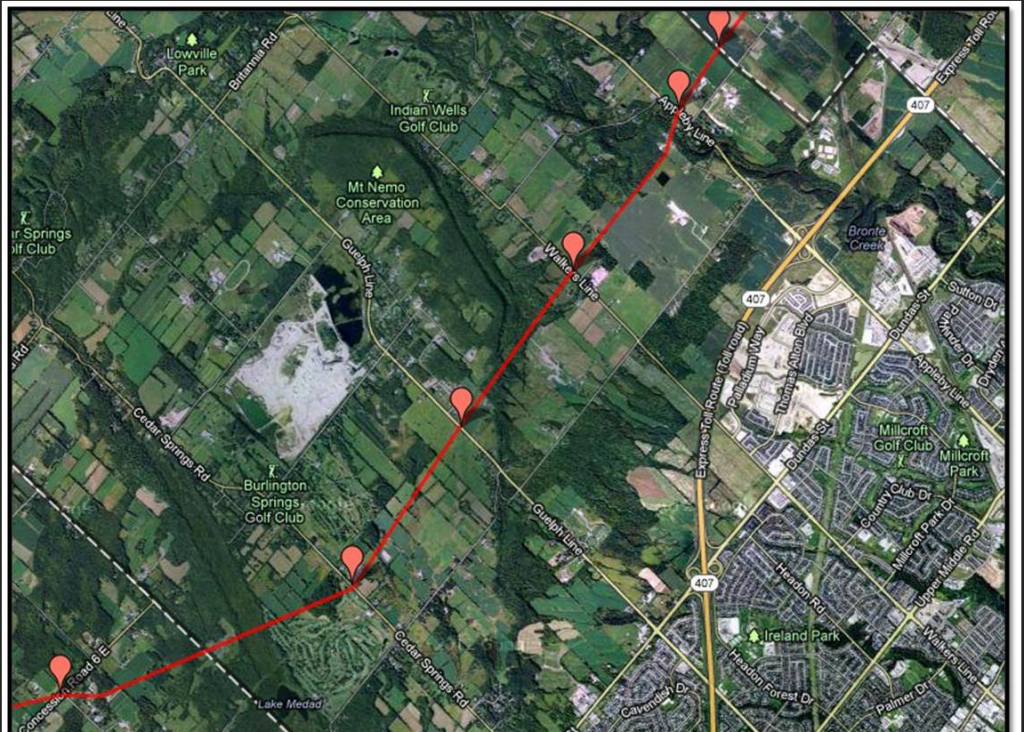 The pipeline that Enbridge wants to use to ship bitumen to Montreal runs right through the top of the city. Other issues raised in the hearings conducted last fall included Enbridge’s request for maximum operating pressures 50 percent greater than at any point in the last decade. The company has admitted that nearly a third of Line 9 leaks. There is widespread concern about the difficulties in cleaning up a spill of bitumen and the toxic diluents released when a rupture occurs.
Since the hearings concluded media investigations have revealed multiple spills that Enbridge failed to report to affected municipalities, and hundreds of Line 9 defects that have been found by the company since it filed its application. It’s unclear if these revelations will be considered by the NEB.
 The route of the pipeline is clearly marked. One wonders what the severe weather is going to have when the frozen ground north of Sideroad # 1 begins to thaw and the ground starts to heave.
Hamilton 350, an advocacy group said in a statement that: “It is clear that we must wean our society off fossil fuels. The minimum first step is stop making things worse. When you find yourself in a hole, the first rule is to stop digging. Therefore, at minimum, no increase in the extraction or transportation of fossil fuels should be contemplated.”
Hamilton 350 also questions the fairness of the NEB process that required detailed application forms from anyone wishing to even submit a written comment to the Board. And they suggest that the credibility of the board’s independence is undermined by its failure to require notification to even the city government for flow expansion last year in another pipeline running parallel to Line 9.
Burlington filed a submission expressing its opposition to any changes to the line. Sometime after the letter of opposition the Burlington Fire department accepted a donation from Enbridge for the development of a simulation lab.
Background links:
Burlington opposes any change in direction of pipeline flow.
City opposes change to pipeline flow then its fire department accepts a $7500 donation.
Burlington tells NEB a pipeline leak would be a disaster for the city.

 By Pepper Parr By Pepper Parr
February 28, 2014
BURLINGTON, ON.
My friend Amy Schnurr, Chief Cheese over at Burlington Green, sent me a piece by David Suzuki that made enough sense for me to pass it along. When we great people, we usually ask them how they are doing. Ask a business person how they are doing and they might tell you THE GDP is up and that they are part of it.
Suzuki suggests that measuring progress with GDP is a gross mistake
Governments, media and much of the public are preoccupied with the economy. That means demands such as those for recognition of First Nations treaty rights and environmental protection are often seen as impediments to the goal of maintaining economic growth. The gross domestic product has become a sacred indicator of well-being. Ask corporate CEOs and politicians how they did last year and they’ll refer to the rise or fall of the GDP.
It’s a strange way to measure either economic or social well-being. The GDP was developed as a way to estimate economic activity by measuring the value of all transactions for goods and services. But even Simon Kuznets, an American economist and pioneer of national income measurement, warned in 1934 that such measurements say little about “the welfare of a nation.” He understood there’s more to life than the benefits that come from spending money.
 The GDP: It’s complex, it’s seen as a standard – and it might be totally useless. My wife’s parents have shared our home for 35 years. If we had put them in a care home, the GDP would have grown. In caring for them ourselves we didn’t contribute as much. When my wife left her teaching job at Harvard University to be a full-time volunteer for the David Suzuki Foundation, her GDP contribution fell. Each time we repair and reuse something considered disposable we fail to contribute to the GDP.
To illustrate the GDP’s limitations as an indicator of well-being, suppose a fire breaks out at the Darlington nuclear facility near Toronto and issues a cloud of radioactivity that blows over the city, causing hundreds of cases of radiation sickness. All the ambulances, doctors, medicines and hospital beds will jack up the GDP. And if people die, funeral services, hearses, flowers, gravediggers and lawyers will stimulate GDP growth. In the end, cleaning up the Darlington mess would cost billions and produce a spike in the GDP.
Extreme weather-related events, such as flooding and storms, can also contribute to increases in GDP, as resources are brought in to deal with the mess. Damage done by Hurricanes Katrina and Sandy and the BP oil spill in the Gulf of Mexico added tens of billions to the GDP. If GDP growth is our highest aspiration, we should be praying for more weather catastrophes and oil spills.
The GDP replaced gross national product, which was similar but included international expenditures. In a 1968 speech at the University of Kansas, Robert Kennedy said, “Too much and for too long, we seemed to have surrendered personal excellence and community values in the mere accumulation of material things …Gross national product counts air pollution and cigarette advertising, and ambulances to clear our highways of carnage. It counts special locks for our doors and the jails for the people who break them. It counts the destruction of the redwood and the loss of our natural wonder in chaotic sprawl. It counts napalm and counts nuclear warheads and armored cars for the police to fight the riots in our cities … and the television programs which glorify violence in order to sell toys to our children.
“Yet the gross national product does not allow for the health of our children, the quality of their education or the joy of their play. It does not include the beauty of our poetry or the strength of our marriages, the intelligence of our public debate or the integrity of our public officials. It measures neither our wit nor our courage, neither our wisdom nor our learning, neither our compassion nor our devotion to our country. It measures everything in short, except that which makes life worthwhile.”
We deserve better indicators of societal well-being that extend beyond mere economic growth. Many economists and social scientists are proposing such indicators. Some argue we need a “genuine progress indicator”, which would include environmental and social factors as well as economic wealth. A number of groups, including Friends of the Earth, have suggested an Index of Sustainable Economic Welfare, which would take into account “income inequality, environmental damage, and depletion of environmental assets.” The Kingdom of Bhutan has suggested measuring gross national happiness.
Whatever we come up with, it has to be better than GDP with its absurd emphasis on endless growth on a finite planet.
Thanks for that Amy.

 By Staff By Staff
February 25, 2014
BURLINGTON, ON
If you are one of those who believes that there is an end to this winter and that Spring will arrive and the flowers will bloom and you are thinking about the work to be done to get your garden ready – there is a place you want to be: Saturday, March 1, from 11 a.m. – 3 p.m. at St. Christopher’s Anglican Church 662 Guelph Line for the Halton Seedy Saturday.
 A large variety of garden seeds will be for sale at the Halton Seedy Saturday. A $2 entrance fee will give you access to a day full of swapping seeds at community seed exchange tables, buying from heirloom and organic seed vendors, learning from garden experts, and garden craft fun for kids. You can also discover community garden opportunities in Burlington and Halton. Food and drink from Family First Organic Meals will be available for purchase.
Featured guest speakers: at 11:15 a.m., Karen Walsh, a Halton Master Gardener, will discuss starting vegetables indoors; at 12:15 p.m., Fran Freeman, an Urban Beekeeper, will present urban beekeeping and attracting pollinators; at 1:15 p.m., Linda Crago, an heirloom vegetable farmer from Tree & Twig will discuss exciting vegetable varieties for your garden; and at 2:15 p.m. Sarah Hemingway from Sarah’s Kitchen Garden, will present growing, cooking and preserving herbs.
Confirmed vendors and exhibitors thus far include: BurlingtonGreen, Greening Sacred Spaces, Oakville Sustainable Food Partnership-Growing & Sharing Food in Halton, Burlington Horticulture Society, Urban Harvest Seeds, Days to Harvest, The Plant Lady, Matchbox Garden & Seed Co., Sarah’s Kitchen Garden, Tree & Twig, Urban Beekeeper, and Halton Master Gardeners.
Additional information can be found at Burlingtongreen. Event proceeds will support Halton community gardens. Non-perishable food items will also be accepted for food bank donation.
Halton Seedy Saturday is brought to you by BurlingtonGreen, Greening Sacred Spaces (Halton-Peel), and Growing & Sharing Food in Halton, with funding support from the Ontario Trillium Foundation.
Background links:
Burlington opens its community garden.

 By Staff By Staff
February 20, 2014
BURLINGTON, ON.
We can’t win. Week upon week of snow and now we are to get rain and need to watch for flooding! The city has 12 crews clearing snow and ice from catch basins and culverts throughout the city,” said Cathy Robertson, director of the roads and parks maintenance department. “They will keep at it until later this evening and then continue again on Thursday.”
Temperatures are predicted to rise to 4 C. How many days ago was it when there were snow plows driving up and down our streets putting piles of snow at the end of our driveways
Residents are asked to assist by checking and clearing storm drains and culverts in front of their homes if they are able to do so.
If there is flooding please call 905-333-6166 between 8:45 a.m. and 4:30 p.m. or email rpm@burlington.ca.

 By Pepper Parr By Pepper Parr
February 14, 2014
BURLINGTON, ON
While city council meeting as a Standing Committee, was listening to delegations on everything from culture, to economic develop and the removal of snow – older people who need walkers, pushed their devices through slush and snow on the sidewalk outside city hall.
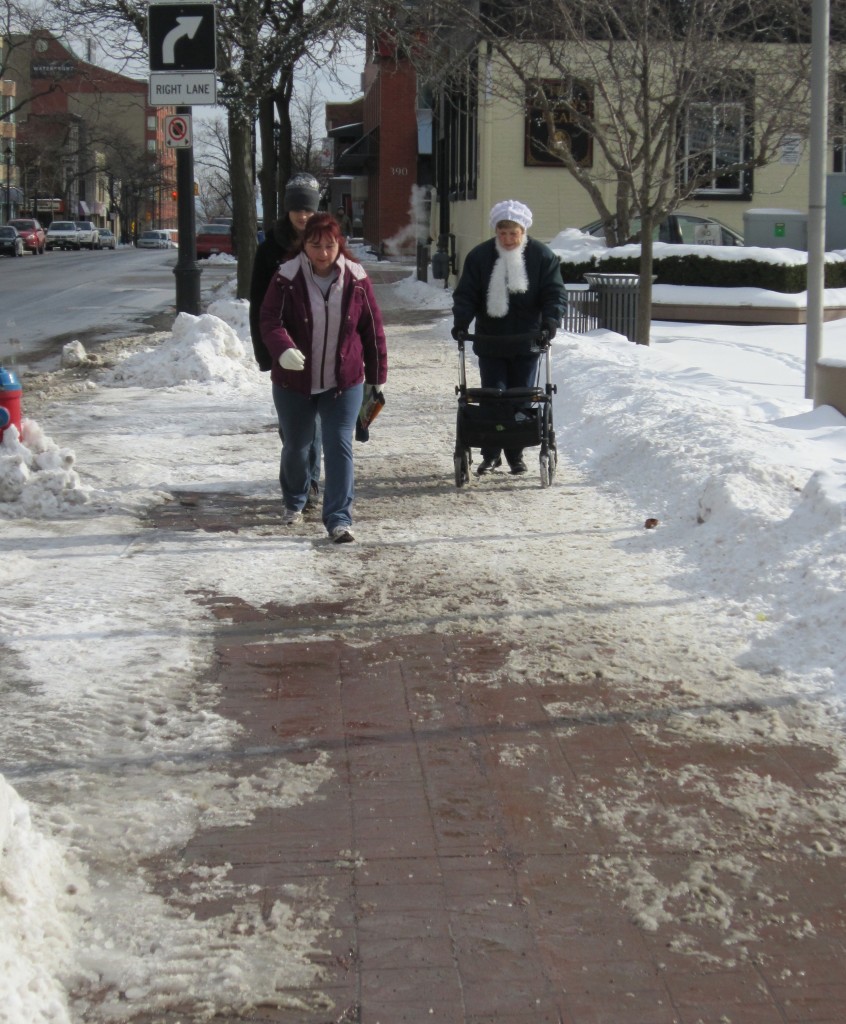 Sidewalk clearing outside city hall a little on the patchy side. Sidewalk across the street, outside a commercial location didn’t have as much as as snowflake on the ground. While at the same time, on the other side of the street, directly across from city hall, outside a commercial establishment there wasn’t as much as a snow flake on the sidewalk.
The yakety, yak, yak, yak puts pay cheques in the bank account of the more than 25 city hall bureaucrats who were in council chambers – but for some reason no one was able to find or direct even one of the 1000+ employees to get a shovel and clear the side-walk.
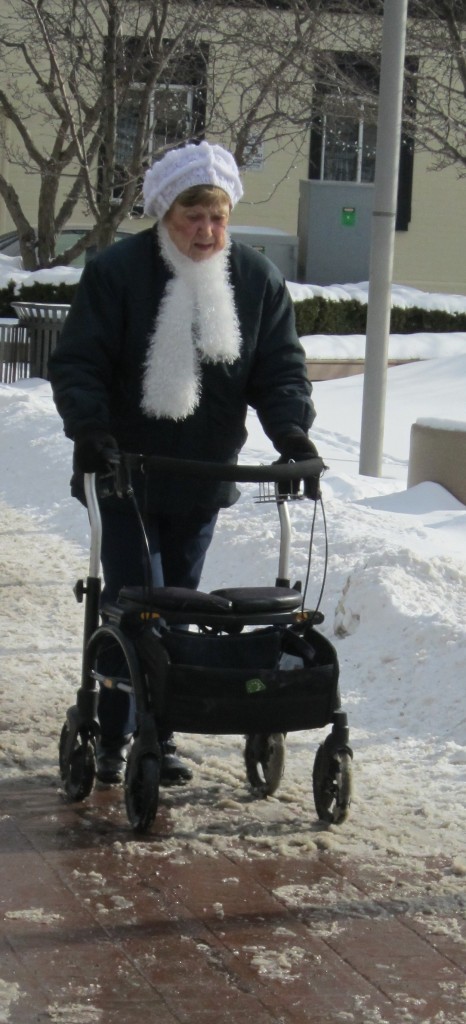 This citizen isn’t smiling. Was she one of the hundreds that were basically locked in their homes during the five days of heavy winter weather because streets were not cleared? It would be nice to say that words are cheap – they actually cost us quite a bit. The action was so easy but you see most of the senior bureaucrats, and the politicians for that matter go out a different door, the back door and they don`t see the state of Brant Street because their cars are parked right outside the building. The bureaucrats have to walk across the road to the indoor parking lot.
We heard during the delegations that clearing of the sidewalks is a city responsibility. Yeah right!

 By Ray Rivers By Ray Rivers
February 6, 2014
BURLINGTON,ON.
There is at least one academic study which claims that increasing the minimum wage would make poverty worse – but the authors note that the result is not statistically significant. And the study is so full-up of assumptions that changing any of them might flip the result. Nevertheless, those opposed to minimum wages hold this up as proof that minimum wages kill jobs and increase poverty, rather than reduce it.
 A raise in the minimum wage of 75 cents an hour isn’t going to produce much – $30 a week at best. Those who support increasing minimum wages disagree and produce their own studies to show a host of benefits. The President of the United States is apparently in that camp and so is Ontario’s Premier. Taking her cue from the Ontario Minimum Wage Advisory Panel, which she appointed last year, she has raised the provincial minimum wage and tied its future to the cost of living. And, she has credibility on her side, since the provincial Liberals’ poverty reduction strategy claims to have lifted almost 50,000 children out of poverty between 2008 and 2011.
 Still, less than ten percent of Ontario’s labour force work for a minimum wage, about half a million workers. And not all those living below the poverty line are employed, so it will take more than raising minimum wages, if solving the poverty problem is our end goal. Raising the income and dignity of those whose only choice is to accept a low-paid job is an important outcome, however, for a government which cares about all residents and not just the well-off. However, eliminating poverty would require a more substantial initiative, including revamping our tax system and some leadership by the federal government. Still, less than ten percent of Ontario’s labour force work for a minimum wage, about half a million workers. And not all those living below the poverty line are employed, so it will take more than raising minimum wages, if solving the poverty problem is our end goal. Raising the income and dignity of those whose only choice is to accept a low-paid job is an important outcome, however, for a government which cares about all residents and not just the well-off. However, eliminating poverty would require a more substantial initiative, including revamping our tax system and some leadership by the federal government.
In the 1970‘s both Canada and US ran pilot projects testing something called a ‘negative income tax’ or ‘guaranteed annual income (GAI)’. The idea was to ensure everyone received a livable income from their work, or would be matched with a government grant if they didn’t. Don’t be alarmed, this concept is somewhat comparable to the existing HST rebate, which goes to lower-income households. The Canadian pilot projects were aborted before the results could be fully evaluated, victims of unusually high unemployment rates, high budgetary deficits and newly elected Conservative governments eager to uproot socialism.
Some of the early results indicated that there would be only a modest impact on labour markets but significant changes to how people use their time – mothers doing more child care, greater family leisure time and enhanced educational activity. Demographics have changed considerably since the 70‘s so the results may not be very useful for implementation today, even were today’s conservatives willing to overlook their oft-recited Protestant creed – ‘the Lord helps them who help themselves’.
 But not all conservatives are spooked by innovative approaches to eliminating poverty. Senator Hugh Segal is a proponent for GAI and argues that such a plan could be funded entirely from the resources being poured into the existing patchwork of poverty reduction programs. In addition, existing welfare programs perversely discourage recipients from looking for work, while GAI would encourage them to top-up their incomes by accepting low paid work – at least until better opportunities come available. But not all conservatives are spooked by innovative approaches to eliminating poverty. Senator Hugh Segal is a proponent for GAI and argues that such a plan could be funded entirely from the resources being poured into the existing patchwork of poverty reduction programs. In addition, existing welfare programs perversely discourage recipients from looking for work, while GAI would encourage them to top-up their incomes by accepting low paid work – at least until better opportunities come available.
Hugh Segal has spent most of his working life as a Progressive Conservative in some capacity or other, including senior aide and chief of staff for Premier Bill Davis and PM Brian Mulroney, and seeking public office himself. He was appointed to the Senate by Liberal PM Paul Martin in a rare moment of non-partisanship, as if Martin was somehow anticipating Justin Trudeau’s recently articulated appointment policy.
But Senator Segal is very much a voice in the wilderness on this issue among the political movers and shakers. Though he may not be too far ahead of the general public, which recent polling shows is becoming interested in, and supportive of, the concept of a guaranteed annual income. Still no political leader seems to have made this a priority. In the meantime I guess we’ll have to settle for Premier Wynne’s inflation-proof minimum wage.
While on this topic I don’t understand why today’s wait-staff (liquor servers) get treated like something out of a Dickens novel. Their minimum wages are set conservatively at about a dollar less than that of other eligible workers, making them reliant on the archaic practice of begging for tips -‘To Insure Prompt Service’. In New Zealand, for example, tipping is infrequent and unexpected because the restaurants there pay their staff decent wages up-front. Even here, some restaurants slap on a mandatory service charge, which presumably goes to the wait-staff and avoids that annoying tipping.
Wouldn’t it be nice if the next time that attractive person waiting on your table flashes those big brown eyes, you know it’s because he, or she, is interested in something other than what’s in your wallet.
 Ray Rivers writes weekly on both federal and provincial politics, applying his more than 25 years as a federal bureaucrat to his thinking. Rivers was a candidate for provincial office in Burlington where he ran against Cam Jackson in 1995, the year Mike Harris and the Common Sense Revolution swept the province. He developed the current policy process for the Ontario Liberal Party. Ray Rivers writes weekly on both federal and provincial politics, applying his more than 25 years as a federal bureaucrat to his thinking. Rivers was a candidate for provincial office in Burlington where he ran against Cam Jackson in 1995, the year Mike Harris and the Common Sense Revolution swept the province. He developed the current policy process for the Ontario Liberal Party.
Background links:
Minimum Wages Study
Policy Alternatives Study
Forbes View
Globe and Mail View
Financial Post View
US Minimum Wage
Minimum Wage Advisory
Canada’s Minimum Wages
Star View
Ontario’s Poverty Reduction
Canada’s Poverty
Guaranteed Annual Income
Poll on GAI
Wait Staff
Hugh Segal

 By Pepper Parr By Pepper Parr
February 5, 2014
BURLINGTON, ON.
I like his idea of service based accountability. I take it to mean that the person responsible for the service is the person accountable – to me. Have I got that right?
So how would this work?
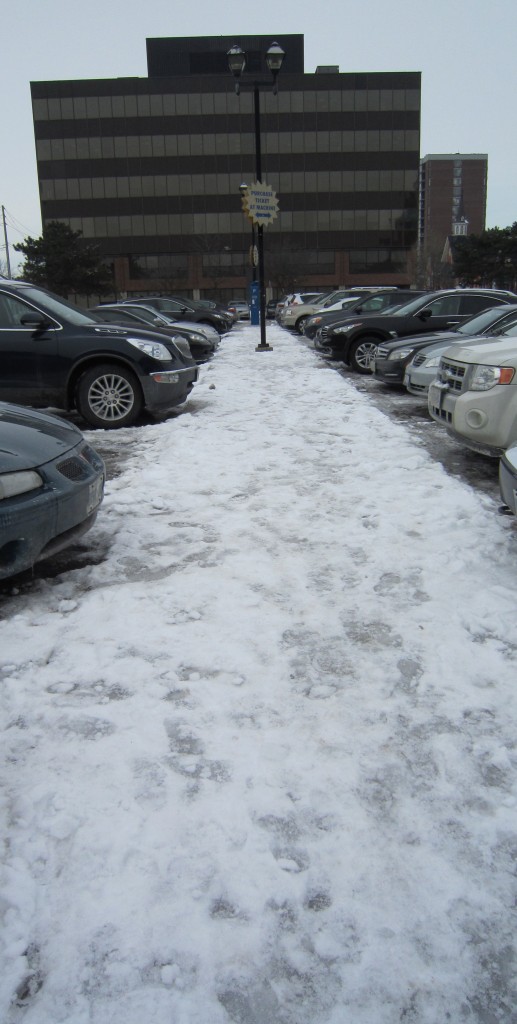 Anyone having to walk along this stretch of sidewalk to put coins in the parking meter is a brave soul. This view looks north to the meter. Let’s try snow removal – specifically the removal of snow from the city parking lots where we pay directly to use the parking spots – the pieces of which went up 25 cents an hour in January. I can live with that.
Now I know there are people in the parking lot every couple of hours checking the meters because on occasion I have found a piece of paper under the windshield wiper inviting me to have an up close and personal with the cashier at city hall who is going to smile as I remove some cash or a credit card from my wallet.
 The view looking south in lot 4 off John Street – notice how they managed to clear the sidewalk in front of the meter but not for the path to the meter. The meter man will certainly know how icy the lot and the little sidewalk is – but he isn’t accountable for the salting and removal of snow. But could he not put in a call to which over department is responsible and say: “Hey guys – the pathway in lot 4 is iced over”.
How do I as a citizen know who is accountable and knowing who that person is – what do I do? Is the city going to give us the telephone numbers for all these people? A couple of years back General Manager Kim Phillips made it very clear the public would not be given names or phone numbers. Let’s not have the riff raff getting in the way of all the civil servants beavering away on our behalf.
So – just how is accountability going to work itself down to my level and my concerns? It is one thing to say that we have an acronym that makes it all very clear; I just want to know what I can do without having to be on the phone for ten minutes – tying up one of those civil servants working so hard for me.
Call your ward councillor – and if you live in ward 2 – that works; Marianne Meed Ward has been known to slip out of her house on Christmas Day to pick up some garbage left on a street. Many have found that they don’t actually have to live in the ward to get service from her. Ticks off the other council members no end when she crosses those ward boundaries.
The service based approach to budgeting makes sense – what isn’t clear is how to connect that service dot and that budget dot to me.
And when that’s done give me some value for the coins I put in that meter.
To be fair, and a more balanced, as some suggest, the Roads and Parks Maintenance people are swamped and there are a lot of roads and sidewalks to be covered. Do they not have contingency plans for situations like this? This is Canada, this in Ontario – we do snow!

 By Pepper Parr By Pepper Parr
February 1, 2014
BURLINGTON, ON.
In April 2013 Burlington resident Denise Davy spoke as a delegation at the city’s Community Services Committee, urging the city to take responsibility for the safety of pedestrians at railway crossings. City Council directed staff to consult with community stakeholders to research rail safety.
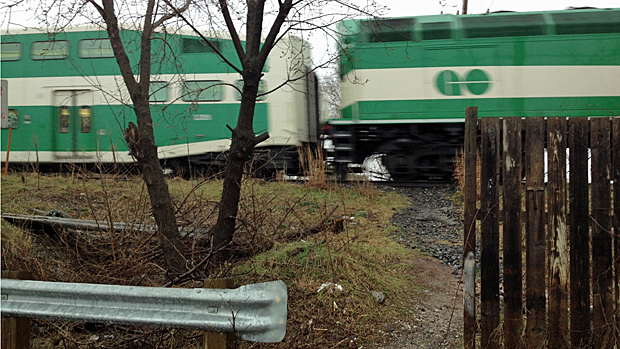 This was the situation in Burlington before Denise Davey delegated to city council for a change. A rail line safety and awareness stakeholder committee was formed to bring the various groups together to review the issue and develop strategies to prevent rail line deaths. The committee included representatives fromGO Transit, CN, VIA Rail, CP, COAST, ROCK, Canadian Mental Health Association, theNorth Halton Mental Health Clinic, Halton Police, Region of Halton Public Works, Transport Canada and theTransportation Safety Board. The review resulted in a number of short-term strategies and long-term opportunities.
 Today there is appropriate fencing and protocols in place to ensure that the city tells the GO people and other authorities that the fence has been breached. It was not quite this easy when Denise Davey first took on the task of making the railway tracks safer by blocking crossing that were not properly secured. Davey’s son, Ryan, was 18 when he was killed by a train in March of 1998. Here is how she tells her story:
“Many more people have been killed by trains going through Halton since then and the numbers over the last year have increased at an alarming rate. In a six-month period, from August 2012 to February 2013, six people were killed, including a 23-year-old Hamilton man.
“That’s a huge increase from previous years and it speaks to the need for better safety measures to prevent further deaths. The area of major concern is along Fairview and Cumberland where many people have been killed by trains.
“It’s wide open and also extremely close to one of the busiest shopping plazas in Burlington. Although there are “Danger” signs posted, the well-worn footpath is a testament to how few people heed them. The same problem exists with the tracks that run between Appleby Line and Burloak, by Sherwood Forest Park.
“Not only are there openings in the fence by the park, but in many areas the bottom part of the fence has been pulled up where people have obviously crawled under. Finding out who is responsible for safety along the tracks was so difficult, however, that even after several calls to rail officials, I’m not completely clear on it.
“Indeed, it seemed even rail officials weren’t clear on it. Transport Canada and the Transportation Safety Board were quick to deflect all blame for any deaths or injuries and talk about the public’s responsibility.
“And there is truth in that. The public needs to be responsible around the tracks. But at some point, the people who run the trains also need to take some responsibility. I can think of several stories I’ve covered as a reporter in which a person was killed crossing the street illegally but a stoplight was later put in place to prevent further deaths or injuries.
“Not only are rail officials quick to deflect blame, they’re tight-lipped when it comes to statistics on train-related fatalities and injuries. After several calls to the GO media folks I was told they don’t have statistics on the number of people who have been killed by GO trains along the Halton tracks.
“How can it be?” I asked the GO spokesperson, “You’re telling me that you don’t know how many people have been killed by the service you run?” I was quickly put on hold then told I needed to talk to someone else. I never got the number from GO.
“I was eventually told by Halton police (who told me earlier they didn’t have the numbers) that five of the six recent deaths in Halton were a result of GO trains.
“I will be talking to members of Burlington city council about changes I think need to be made to areas along the tracks. They include fencing, surveillance cameras, motion sensitive lighting and noise barriers, the same type you see along the QEW in Grimsby.
“I figure if they’re deemed important enough to buffer noise for residents who live close to the highway, they should be considered important enough to save a life.”
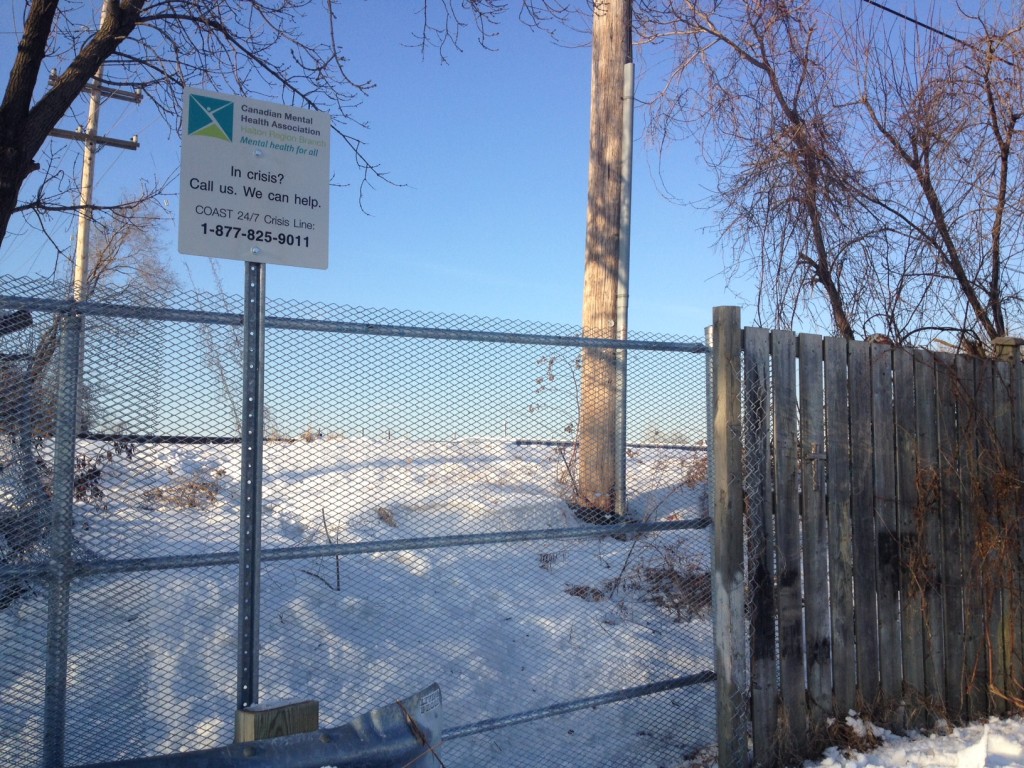 Will the sign make a difference? If it doesn’t – well we tried. But if it does – that is a victory. Denise Davey deserves great credit for her efforts. Keep her in mind when it comes to selecting Burlington`s Best. It was an uphill fight for a long period of time but at a city council meeting in January Bruce Zvaniga, director of transportation services said: “The various stakeholders came to the table prepared to discuss and make changes,” said Zvaniga, and “I would like to thank them for their responsiveness, action and commitment to safety.”
The committee has already put in place a number of short-term strategies, including:
A communication protocol where city staff share information with rail operators regarding fence damage and footpaths near the rail line. Rail operators are also to share information with roads and parks maintenance staff regarding fence damage on city-owned properties
Rail operator “high rail” reviews that exchange information about identified outcomes
City fencing improvements in five different locations where chain fences will be installed
Rail line safety and awareness in 11 public schools and seven catholic schools as part of the schools’ safety awareness programs and under the leadership of Operation Lifesaver
Site specific strategies have been implemented by GO Transit and the Canadian Mental Health Association
“I am very proud of the work done by the stakeholder committee,” said Mayor Rick Goldring. “ The committee has created a set of best practices for the entire country. If what we have set in motion can save one life, than it has well be worth it.”
An annual stakeholder review process is now in place. The stakeholder group will meet each year to look at the outcomes of previous strategies, identify possible new strategies and discuss long-term opportunities. In 2014, the committee will invite the Catholic and public school boards to participate.
Somewhere along the way the woman who had lost a child to a rail line accident got forgotten as all the bureaucrats who should have been on top of this issue from the beginning did nothing until Denise Davey delegated.
The power of one person with a voice and the courage of their convictions is immense and magnificent.
Background links:
City staff directed to start asking questions.
Three deaths in seven months.
Parent wants better rail line safety – death level intolerable.

 By Pepper Parr By Pepper Parr
January 28, 2014
BURLINGTON, ON
It started as a pilot project in North Burlington during 20131 that proved to be a remarkable success. At that time the city gave Community Development Halton (CDH) $86,000 to strengthen community at the neighbourhood level by actively engaging community members and agencies and to continue increasing access to recreation and culture within neighbourhood spaces.
The measurables are remarkable. CDH took the money and leveraged it to bring in $40,000 in kind and recorded 3130 in volunteer hours. Few organization can talk in terms of that number of volunteer time.
The pilot did more than that – it brought out a response from the faith communities who have opened their doors and their arms and hosted events. One of the early offerings was community dinners which irked some because they felt city money was being used to feed people dinner – that’s not where the dollars went.
How does a social planner explain what they do? Listen to Rishia
The dollars went to fund a community social planner who managed to convince a sports team from Hayden High in Alton to prepare and serve one of those dinners. The socioeconomic differences between these two groups – North Burlington residents and Hayden high students creates an understanding, a tolerance and an appreciation of each other.
 Community Development Halton Executive Director Joey Edwardh at an AGM Joey Edwardh, CDH Executive Director, explains that neighbourhood development is not a social service. Vibrant neighborhoods is a formative pillar in the city’s Strategic Plan. The social planner that was hired is on the ground working with people in the community to “connect the dots”. A city is more than bike paths and roads that are in good repair – the city is its people says Edwardh with some gusto.
The pilot project now has many of its dis-advantaged people serving lunches to seniors in faith community settings.
Neighbourhoods are the first point of contact for members of council – and this city has neighbourhoods that are not visible – much the way it took city council some time to become aware of the vibrant art and culture groups in the city – few knew they were even there.
One of the harder realizations for people who work in disadvantaged communities is spotting the lack of aspirations on the part of these young people. Their parents cannot afford to put their children into hockey programs, they can’t pay for tickets to Performing Arts events – lunch money is a stretch most of the time. Joining the Burlington Teen Tour Band is totally out of the question.
Each of these would be said to be what defines Burlington and that wouldn’t be a false statement – but for many, far more than most of us realize, being part of these defining groups is a hard reality for the disadvantage.
Is community development a city responsibility? If the city is to be “vibrant” development has to be done at the community level and that is easier to do in some communities that it is in others.
Some feel this kind of service gets done by the Regional government. The Region delivers and over sees services mandated by the province and includes services that are more effectively and economically delivered by the Region.
Community Development Halton has a rich history in the field of community development. It grew out of social councils that were operational back when Roly Bird and Walter Mulkewich were Mayors and current provincial Minister of Community Services Ted McMeekin was employed as the Executive Director of the original social council in Burlington.
Some ground breaking reports came out of CDH and some now very successful community organizations were incubated at went on to become a part of the fabric that keeps the city together. Food for Thought – a program that ensures students who are not being fed properly get the meals and the nutrition they need. Today we wouldn’t think of not having Food for Thought.
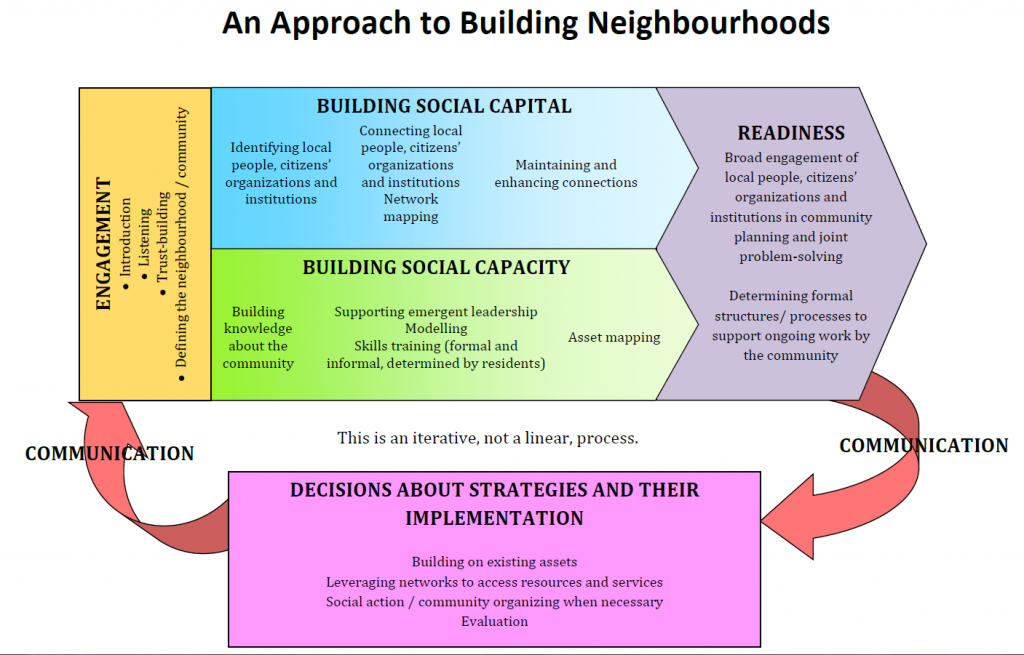 What do you get for $86,000 – what do you think of this for a process. Can you see your city in there? 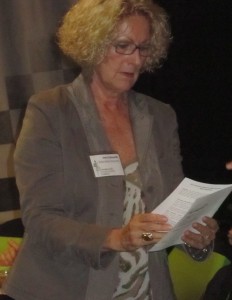 Shuffling the papers as she prepares to speak Community Development HAlton Executive Director Joey Edwardh delivers the message With the funding Edwardh is seeking for 2014 community development at the neighbourhood level could begin in South East and Central Burlington.
The business case submitted to council’s budget review process fits well with the city’s Leisure Services Policy and Community Development Policy. It is similar to the approach taken regarding Community Gardens. This business case is based on a 1% increase over the city’s investment in the pilot project in 2013. Mid year and end of year reporting to the City of Burlington will be expected.
There is some additional work to be done at the city/Regional level clarifying a “place based” neighbourhood strategy that meets the needs of the City of Burlington and the Region of Halton, considering each level of government’s service responsibilities. The City will have completed service business plans and will be ready for service based budgets in the 2015 budget.
Community is eclectic, chaotic and doesn’t grow with constraints. Community is people – they come in all sizes shapes and colours.
The argument for funding this program will be delegated on February 4th – the decision will say a lot about the kind of city we really are.

|
|





















































 Still, less than ten percent of Ontario’s labour force work for a minimum wage, about half a million workers.
Still, less than ten percent of Ontario’s labour force work for a minimum wage, about half a million workers. But not all conservatives are spooked by innovative approaches to eliminating poverty.
But not all conservatives are spooked by innovative approaches to eliminating poverty.












